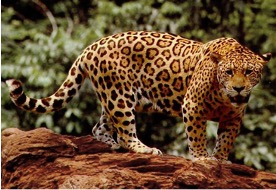Published on: December 1, 2022

International Jaguar Day
International Jaguar Day

Why in news?
International Jaguar day observed annually on November 29, it celebrates the Americas’ largest wild cat as an umbrella species for biodiversity conservation
Highlights
- On international Jaguar day , National Zoological Park, New Delhi, organized activities like a Zoo Walk and an Expert talk on ‘Big Cats and Jaguars’,
- It is an icon for sustainable development and the centuries-old cultural heritage of Central and South America.
- This is the third largest Cat Predator in the World and an important species of the Amazon Rainforest.
What is the main aim of Programme ?
- Collective voice of jaguar range countries, in collaboration with national and international partners
- To draw attention to the need to conserve jaguar corridors and their habitats as part of broader efforts to achieve the United Nation’s Sustainable Development Goals.
Jaguar 2030 Roadmap
- It is a range-wide effort that unites range country governments, non-governmental and inter-governmental organizations, local communities, and the private sector around a shared vision to conserve jaguars and their valuable ecosystems.
- The Roadmap aims to strengthen the Jaguar Corridor across range countries by securing 30 priority jaguar landscapes by 2030 by reducing jaguar-human conflict in human dominated landscapes, and increasing the security and connectivity of core protected landscapes.
How Jaguars and Leopards are differentiated ?
- It can be differentiated due to the spots within the rosettes on their coats.
- While many cats avoid water, jaguars are great swimmers and have even been known to swim the Panama Canal.
About Jaguar
- It is a large cat species and the only living member of the genus Panthera native to the Americas
- The jaguar’s powerful bite allows it to pierce the carapaces of turtles and tortoises, and to employ an unusual killing method
- Range : Southwestern United States across Mexico and much of Central America, the Amazon rainforest and south to Paraguay and northern Argentina.
- Habitation : forested and open terrains, but its preferred habitat is tropical and subtropical moist broadleaf forest, wetlands and wooded regions
- IUCN Red List: Near Threatened
-
Cockscomb Basin Wildlife Sanctuary was established in Belize as the world’s first protected area for jaguar conservation

